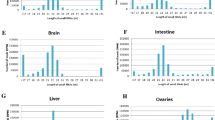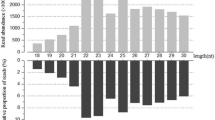Abstract
The Nile tilapia (Oreochromis niloticus; Cichlidae) is an economically important species in aquaculture and occupies a prominent position in the aquaculture industry. MicroRNAs (miRNAs) are a class of noncoding RNAs that post-transcriptionally regulate gene expression involved in diverse biological and metabolic processes. To increase the repertoire of miRNAs characterized in tilapia, we used the Illumina/Solexa sequencing technology to sequence a small RNA library using pooled RNA sample isolated from the different developmental stages of tilapia. Bioinformatic analyses suggest that 197 conserved and 27 novel miRNAs are expressed in tilapia. Sequence alignments indicate that all tested miRNAs and miRNAs* are highly conserved across many species. In addition, we characterized the tissue expression patterns of five miRNAs using real-time quantitative PCR. We found that miR-1/206, miR-7/9, and miR-122 is abundantly expressed in muscle, brain, and liver, respectively, implying a potential role in the regulation of tissue differentiation or the maintenance of tissue identity. Overall, our results expand the number of tilapia miRNAs, and the discovery of miRNAs in tilapia genome contributes to a better understanding the role of miRNAs in regulating diverse biological processes.




Similar content being viewed by others
References
Bartel DP (2004) MicroRNAs: genomics, biogenesis, mechanism, and function. Cell 116:281–297
Lee RC, Feinbaum RL, Ambros V (1993) The C. elegans heterochronic gene lin-4 encodes small RNAs with antisense complementarity to lin-14. Cell 75:843–854
He L, Hannon GJ (2004) MicroRNAs: small RNAs with a big role in gene regulation. Nat Rev Genet 5:522–531
Reinhart BJ, Slack FJ, Basson M et al (2000) The 21-nucleotide let-7 RNA regulates developmental timing in Caenorhabditis elegans. Nature 403:901–906
Sunkar R, Li Y-F, Jagadeeswaran G (2012) Functions of microRNAs in plant stress responses. Trends Plant Sci 17:196–203
Lacerda SM, Batlouni SR, Costa GM et al (2010) A new and fast technique to generate offspring after germ cells transplantation in adult fish: the Nile tilapia (Oreochromis niloticus) model. PLoS ONE 5:e10740
Kocher TD (2004) Adaptive evolution and explosive speciation: the cichlid fish model. Nat Rev Genet 5:288–298
Won Y-J, Wang Y, Sivasundar A, Raincrow J, Hey J (2006) Nuclear gene variation and molecular dating of the cichlid species flock of Lake Malawi. Mol Biol Evol 23:828–837
Hulsey CD (2006) Function of a key morphological innovation: fusion of the cichlid pharyngeal jaw. Proc R Soc Edinb Biol 273:669–675
Mazzuchelli J, Kocher T, Yang F, Martins C (2012) Integrating cytogenetics and genomics in comparative evolutionary studies of cichlid fish. BMC Genomics 13:463
David R (2012) Non-coding RNAs: a new member of the family. Nat Rev Mol Cell Biol 13:686
Loh Y-HE, Katz LS, Mims MC, Kocher TD, Yi SV, Streelman JT (2008) Comparative analysis reveals signatures of differentiation amid genomic polymorphism in Lake Malawi cichlids. Genome Biol 9:R113
Loh Y-HE, Soojin VY, Streelman JT (2011) Evolution of microRNAs and the diversification of species. Genome Biol Evol 3:55
Yan B, Guo J-T, Zhao L-H, Zhao J-L (2012) microRNA expression signature in skeletal muscle of Nile tilapia. Aquaculture 364–365(5):240–246
Huang C, Li Y, Hu S et al (2012) Differential expression patterns of growth-related microRNAs in the skeletal muscle of Nile tilapia (Oreochromis niloticus). J Anim Sci 90:4266–4279
Loh Y-HE, Katz LS, Mims MC, Kocher TD, Yi SV, Streelman JT (2008) Comparative analysis reveals signatures of differentiation amid genomic polymorphism in Lake Malawi cichlids. Genome Biol 9:R113
Loh Y-HE, Soojin VY, Streelman JT (2011) Evolution of microRNAs and the diversification of species. Genome Biol Evol 3:55
Fujimura K, Okada N (2007) Development of the embryo, larva and early juvenile of Nile tilapia Oreochromis niloticus (Pisces: Cichlidae). Developmental staging system. Dev Growth Differ 49:301–324
Li R, Yu C, Li Y et al (2009) SOAP2: an improved ultrafast tool for short read alignment. Bioinformatics 25:1966–1967
Gardner PP, Daub J, Tate JG et al (2009) Rfam: updates to the RNA families database. Nucleic Acids Res 37:D136–D140
Zuker M (2003) Mfold web server for nucleic acid folding and hybridization prediction. Nucleic Acids Res 31:3406–3415
Chen C, Ridzon DA, Broomer AJ et al (2005) Real-time quantification of microRNAs by stem-loop RT-PCR. Nucleic Acids Res 33:e179
Roush S, Slack FJ (2008) The let-7 family of microRNAs. Trends Cell Biol 18:505–516
Horner DS, Pavesi G, Castrignanò T et al (2010) Bioinformatics approaches for genomics and post genomics applications of next-generation sequencing. Brief Bioinform 11:181–197
Kozomara A, Griffiths-Jones S (2011) miRBase: integrating microRNA annotation and deep-sequencing data. Nucleic Acids Res 39:D152–D157
Pasquinelli AE, Reinhart BJ, Slack F et al (2000) Conservation of the sequence and temporal expression of let-7 heterochronic regulatory RNA. Nature 408:86–89
Yang B, Lin H, Xiao J et al (2007) The muscle-specific microRNA miR-1 regulates cardiac arrhythmogenic potential by targeting GJA1 and KCNJ2. Nat Med 13:486–491
Brodersen P, Voinnet O (2009) Revisiting the principles of microRNA target recognition and mode of action. Nat Rev Mol Cell Biol 10:141–148
Maragkakis M, Alexiou P, Papadopoulos GL et al (2009) Accurate microRNA target prediction correlates with protein repression levels. BMC Bioinformatics 10:295
Li Y, Zhang Z, Liu F, Vongsangnak W, Jing Q, Shen B (2012) Performance comparison and evaluation of software tools for microRNA deep-sequencing data analysis. Nucleic Acids Res 40:4298–4305
Berezikov E, Robine N, Samsonova A et al (2011) Deep annotation of Drosophila melanogaster microRNAs yields insights into their processing, modification, and emergence. Genome Res 21:203–215
Berezikov E (2011) Evolution of microRNA diversity and regulation in animals. Nat Rev Genet 12:846–860
Hertel J, Bartschat S, Wintsche A, Otto C, Stadler PF (2012) Evolution of the let-7 microRNA Family. RNA Biol 9:231–241
Christodoulou F, Raible F, Tomer R et al (2010) Ancient animal microRNAs and the evolution of tissue identity. Nature 463:1084–1088
Niwa R, Slack FJ (2007) The evolution of animal microRNA function. Curr Opin Genet Dev 17:145–150
Liu N, Okamura K, Tyler DM, Phillips MD, Chung W-J, Lai EC (2008) The evolution and functional diversification of animal microRNA genes. Cell Res 18:985–996
Noland CL, Doudna JA (2013) Multiple sensors ensure guide strand selection in human RNAi pathways. RNA 19:639–648
Bushati N, Cohen SM (2007) microRNA functions. Annu Rev Cell Dev Biol 23:175–205
Lu J, Shen Y, Wu Q et al (2008) The birth and death of microRNA genes in Drosophila. Nat Genet 40:351–355
Meunier J, Lemoine F, Soumillon M et al (2013) Birth and expression evolution of mammalian microRNA genes. Genome Res 23:34–45
Yan B, Zhu C-D, Guo J-T, Zhao L-H, Zhao J-L (2013) miR-206 regulates the growth of the teleost tilapia (Oreochromis niloticus) through the modulation of IGF-1 gene expression. J Exp Biol 216:1265–1269
Yan B, Zhao J-L (2012) MiR-30c: a novel regulator of salt tolerance in tilapia. Biochem Biophys Res Commun 452:153–320
Acknowledgments
This work was supported by Shanghai Educational Development Foundation (Grant No. 12CG56 to B.Y.), the Specialized Research Fund for the Doctoral Program of Higher Education of China (Grant No. 20123104120005 to B.Y.), and China Agriculture Research System (Grant No.CARS-49-4B to J.-L.Z.).
Conflict of interest
The authors have declared that no competing interests exist.
Author information
Authors and Affiliations
Corresponding authors
Additional information
Biao Yan and Zhen-Hua Wang have contributed equally to this work.
Electronic supplementary material
Below is the link to the electronic supplementary material.
Rights and permissions
About this article
Cite this article
Yan, B., Wang, ZH., Zhu, CD. et al. MicroRNA repertoire for functional genome research in tilapia identified by deep sequencing. Mol Biol Rep 41, 4953–4963 (2014). https://doi.org/10.1007/s11033-014-3361-9
Received:
Accepted:
Published:
Issue Date:
DOI: https://doi.org/10.1007/s11033-014-3361-9




